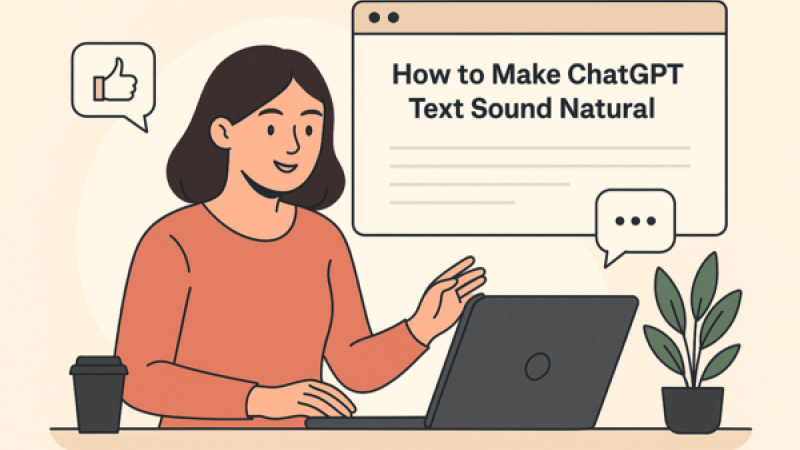So… ever read something that feels like it was written by a toaster?
Yeah. Same.
I recently had ChatGPT help me write a product description. Great facts. Clear structure. But something about it was off. Like, if a human had written it, I’d ask if they were okay.
AI-generated content often sounds robotic, and that’s a problem. Whether it’s for LinkedIn posts, YouTube scripts, or even a school essay — people can tell when something’s missing that messy, unpredictable human energy. And not just people — even AI detectors like GPTZero, WinstonAi or Originality.ai can sniff it out.
So yeah. If your plan is to copy-paste ChatGPT's first draft into your blog... don’t publish it as-is.
So, how do you turn a good-but-awkward ChatGPT draft into natural, authentic-sounding writing?
Let me walk you through how I wrestle the weirdness out of AI writing — and why you definitely need the human layer.
Step 1: Spot the Weirdness
Most people think robotic means cold or boring. But it’s more than that. Some red flags:
- Same sentence length, over and over. Like a metronome of mediocrity.
- Weirdly stiff phrases. Ever read “in conclusion” on a Twitter post? Exactly.
- No actual feelings. Like you're being talked at, not spoken to.
- Passive voice. “The product was used by customers” — huh?
- No detail. No texture. No life.
Here’s a sentence ChatGPT gave me once:
> “Social media marketing is important. It helps businesses grow. Many companies use it to reach their audience.”
Cool. But also, what does that even feel like? I can’t smell the coffee. I can’t hear the click of someone hitting 'share.'
Step 2: Humanize It (With Help)
Once you’ve got your raw AI text, don’t just tweak a word or two. That’s like putting lipstick on a robot.
Instead, I plug it into TrueWrite — it’s built to humanize AI-generated text with actual nuance. What I like about it?
- It mixes up the rhythm. Sentences feel more alive.
- It swaps robotic words for real ones.
- It somehow rewires the logic too — not just fluffing it up, but totally reshaping how ideas unfold.
I’ve used it for cold emails, product blurbs, even parts of essays and assignments. It’s like having a semi-awkward but super helpful cousin take a pass before I publish.
And yes, it keeps your formatting intact. No weird spacing. No data gets stored. (That part was important for me after I once pasted in a client draft and instantly panicked.)
Learn more about how TrueWrite works
Step 3: Double-Check the Robots Didn’t Notice
If your content’s going public or getting graded, I’d run it through those detectors again. Just to be sure.
I’ve compared scores before and after TrueWrite — and we’re talking a legit dramatic drop in detectability. The cool part? It doesn’t just change words. It reworks the logic. Like how a human actually explains things.
So it doesn’t trip the alarms.
Step 4: Give It One More Human Touch
Here’s where I usually add a weird metaphor, a smell, or something oddly personal.
Like the time I tried to explain SEO using chicken nuggets. (Long story.)
Just read your final version out loud. Ask yourself:
- Would I say this out loud to someone I respect?
- Does anything feel too clean? Too... sanitized?
- Can I throw in one memory? Or one strangely specific image?
This last step’s quick. But it’s where the actual magic happens. You don’t need to be Shakespeare. Your weird little story about a lost sock might be the thing that makes the reader trust you.
Not Just for Blogs
This trick works everywhere tone matters:
- Product descriptions that don’t sound like manuals
- Landing pages that hold attention longer than 3 seconds
- LinkedIn posts that make people message you instead of scrolling
- YouTube scripts that don’t sound like your Roomba wrote them
Basically, whenever you want to sound like you... instead of a data model pretending to be excited about accounting software.
Final thought before I go make a sandwich and forget what day it is:
AI is a killer shortcut. But it’s not the finish line. It's like an overenthusiastic intern with zero sense of humor. You still need the messy, unpredictable human layer.
And for me? TrueWrite is the fastest way to create high-quality content. It makes AI useful — without letting it talk like it runs a PowerPoint cult.
Anyway. That’s my rant.
Paste your text now and see the difference

